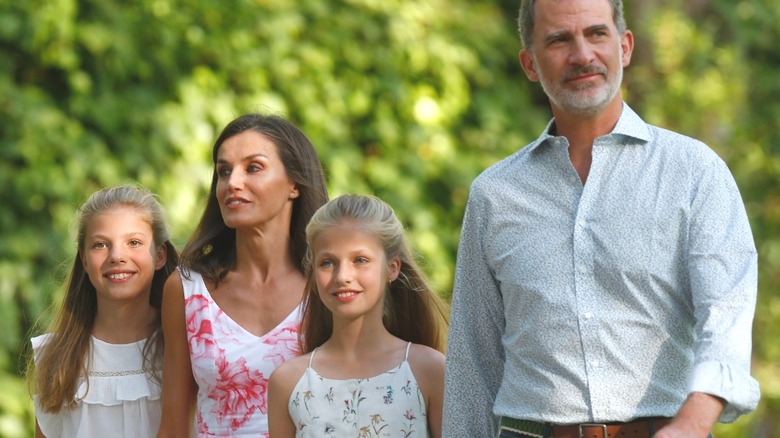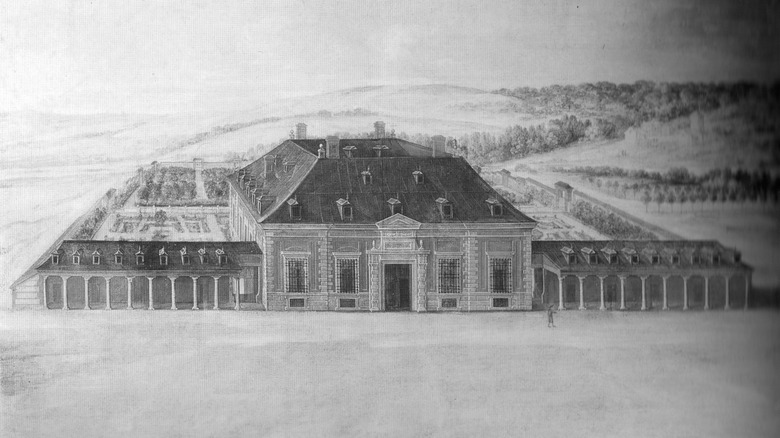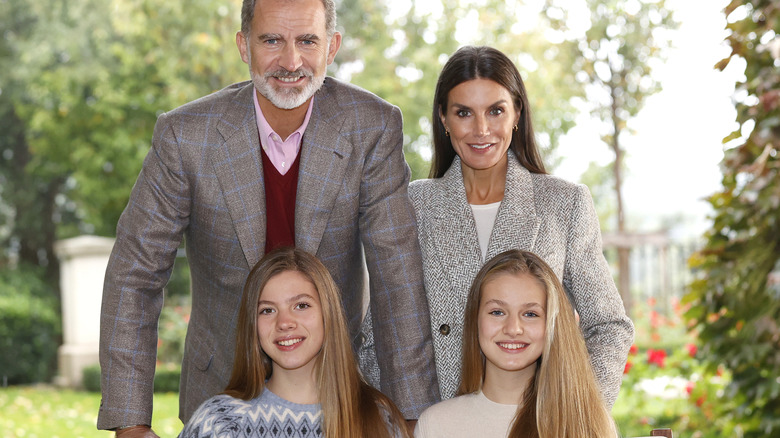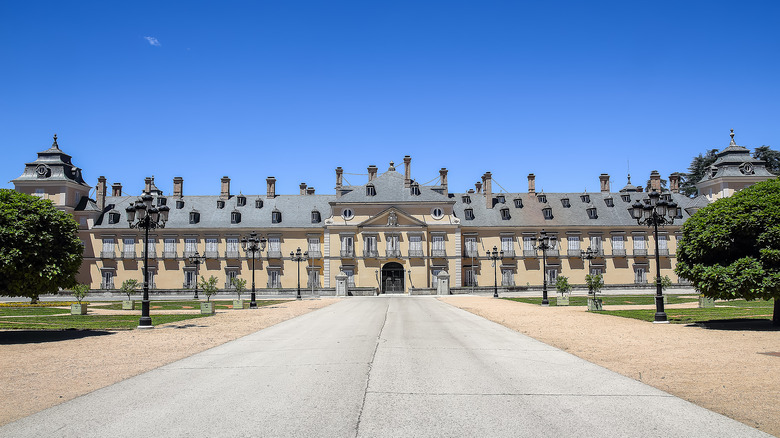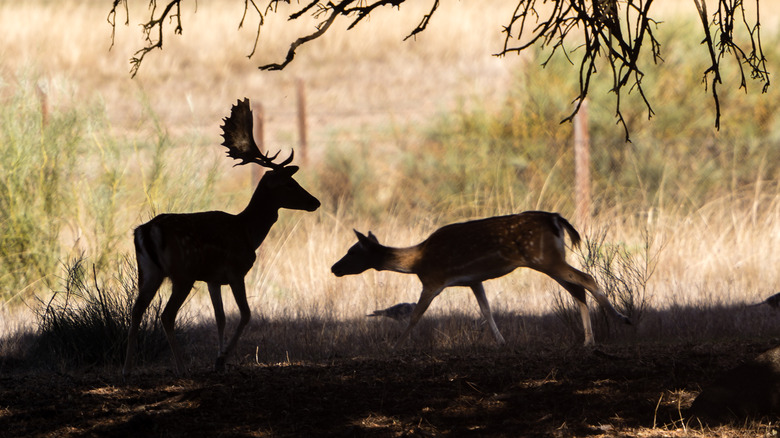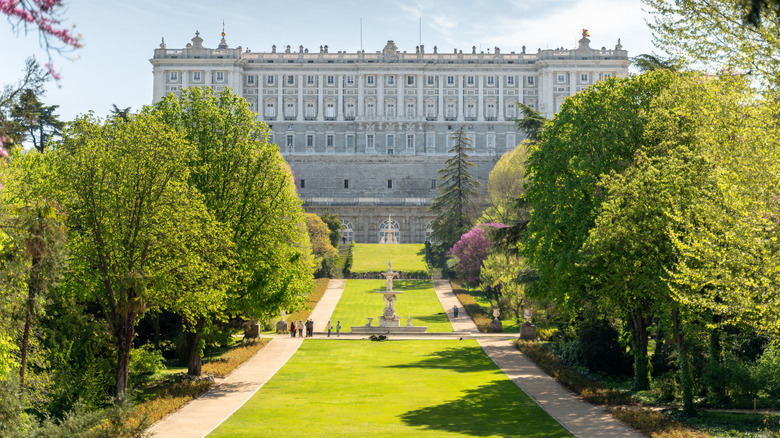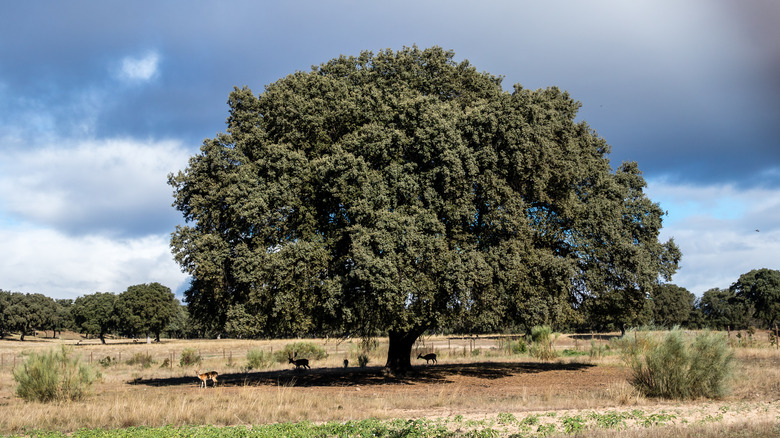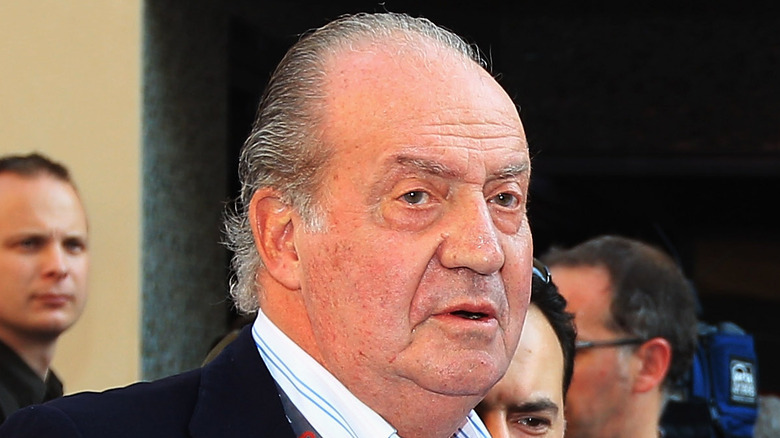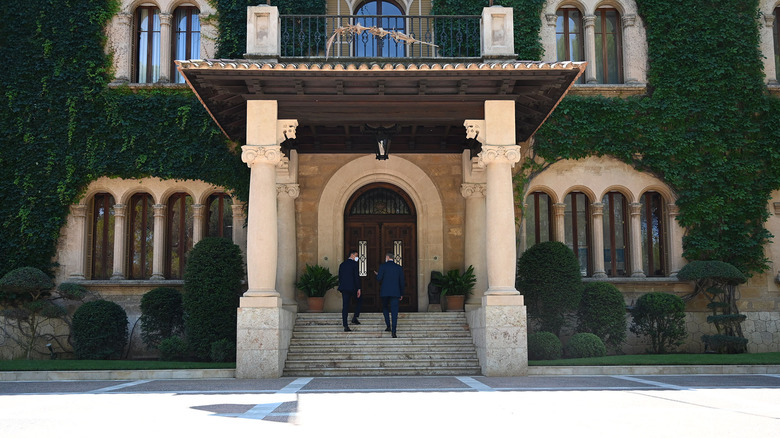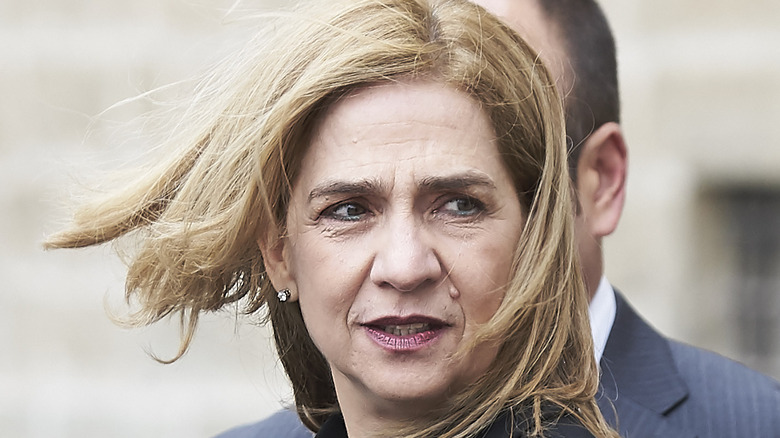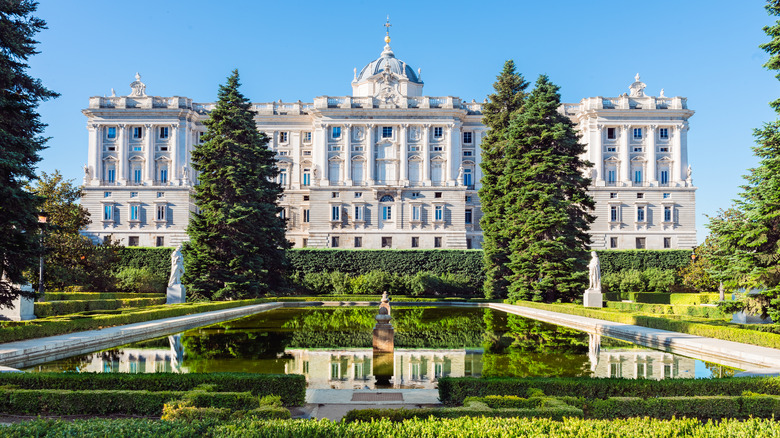This Is Where The Spanish Royal Family Lives
King Felipe VI and Queen Letizia of Spain are one of our favorite royal power couples to talk about. From their gorgeous royal wedding and matching suits to their sweet family dynamic and more down-to-earth approach to the monarchy, they're the first people we think of when it comes to modern monarchs. Felipe got engaged to his soon-to-be-wife in 2003 and married her a year later (per Casa Real). Together, they have two children, Princess Leonor and Princess Sofía. The press has often shared pictures of the family taking walks around town, and the atmosphere is generally relaxed.
Since taking the throne in 2014, the king and queen have made many efforts to distance themselves from the inherited drama of the Spanish royal family and the excessive luxury that's associated with royal living. As Letizia and Felipe continue to work on reforming the monarchy in their ideal image, it's a good time to take stock of where the Spanish royals are living these days and discuss how they all became scattered around the globe in the first place. Through our research, we were able to find out quite a bit about each member of the family, and the jaw-dropping estates they've enjoyed over the years.
Zarzuela Palace is their private family home
Zarzuela Palace, nestled in the foothills between the royal grounds of El Pardo and the busy streets of Madrid, is the private residence of the royal Spanish family. Former King Juan Carlos I and his wife, Queen Sofía, lived there together for most of their reign. Following his 2014 abdication and 2020 departure from Spain, the property has been shared among other close relatives and foreign dignitaries during official visits. Researchers Pedro Gómez Manzanares and Christopher Webber attributed the palace's name to the brambles, "zarzas" in Spanish, that grew nearby (per Zarzuela.net), but the term "La Zarzuela" later became associated with Spanish opera.
The red-bricked mansion dates back to the 1600s, when the first iteration of it was commissioned by the crown (per Royal Central). According to an archived article from El Mundo, King Carlos IV rebuilt the palace and furnished it with a collection of impressive decor. The palace was also rebuilt after it was extensively damaged during the Spanish Civil War in the 1930s.
But King Felipe's family lives separately in the Prince's Pavilion
Though King Felipe's parents previously occupied Zarzuela Palace itself, the new king and queen prefer to use the nearby Prince's Pavilion as their family home (per Hello). The pavilion, which was created for then-Prince Felipe prior to his marriage to Letizia, has relatively simple decor despite its large, luxurious layout and amenities (per Popsugar). From the front, their house looks as normal as any modern home, with a shingled roof and siding that appears to be stucco (per Unofficial Royalty). The huge circular driveway gives this upscale suburb-style house a finishing royal touch.
As you can see from these adorable 2012 pictures, the family has enjoyed casual outdoor seating, a jungle gym, and all the usual comforts of home over the years — on a larger scale, of course. Most of the pictures they've shared publicly, including their visit with then-first lady Michelle Obama, show them enjoying the outdoors, so we can assume the garden is one of their favorite places to entertain (per Popsugar).
Some royals used the Palace of El Pardo as a winter home
The Royal Palace of El Pardo, which was commissioned in the 16th century by Charles V, is located on Monte de El Pardo as part of a larger royal compound (per Patrimonio Nacional). Dictator Francisco Franco took it over during the Spanish Civil War (per Welcome to Madrid). Since 1983, the Spanish royal family has used it to host foreign heads of state. Historically, older generations of royals also used it as a winter home.
According to Patrimonio Nacional, "The palace was finished by Philip II, who introduced Flemish-style slate roofs here for the first time, with high trestles and spikes, and who decorated its interior in the Italian style with large frescoes and with the portrait gallery, which included masterpieces of this genre by Tiziano, Antonio Moro, and their followers." Ultimately, the king's descendants had to redecorate it after a fire pretty much destroyed everything except the buildings themselves in 1604. It's best known for its famous tapestries and frescoes, including works by Francisco de Goya and Gaspar Becerra (per Casa Real). Fun fact: did you know episodes of "Cuéntame cómo pasó" were filmed at the royal palace?
The Royal Palace of El Pardo was once used as a hunting lodge
With its plentiful variety of deer, boars, birds of prey, and other popular game, El Pardo, which means "brownish-gray" in Spanish, was once a hunting ground enjoyed by the royals of old. As early as the Middle Ages, the kings of Castile flocked here to hunt. King Henry III built a castle to accommodate the sport in the 15th century. Later, a large hunting lodge called Torre de la Parada, which had a distinctive spire, was constructed. It housed a collection of important artworks (per "The Decoration of the Torre de la Parada"). The lodge was destroyed and ransacked in 1710 by Austrian troops (per Time).
According to Patrimonio Nacional, Charles V decided to rebuild the small castle on the site in the 16th century, hiring architect Luis de Vega, "who made a small traditional Spanish square fortress with protruding towers at the corners and ringed by a moat ... as shown by the main entrance and the courtyard galleries, where the coats of arms and emblems evoke the emperor."
The royal gardens of Spain are a sight to see
If you were hoping for a closer look, you're in for a treat! The royal grounds at El Pardo, including its palaces and beautiful gardens, are open to the public year-round for a small entrance fee (per Patrimonio Nacional). Patrimonio Nacional, the Spanish equivalent to the U.S. National Park Service, manages this estate, in addition to several others in the area (per Casa Real). Outside of the royal palace, you can explore sprawling lawns (in the style of Versailles), flower-lined fountains, and scenic overlooks of the Manzanares River. Parterre Garden, just south of the palace, is particularly beautiful with its towering, ancient trees. A sign at the park reads, "Within the more than 500-hectare-wide Spanish historical gardens, there are almost 100,000 trees."
If you're up for a quick drive, Campo del Moro Gardens are about 20 minutes from El Pardo. These 20 hectares of gardens, also once owned by the Spanish royal family, are considered a hidden gem: "Today, the Campo del Moro Gardens are one of the favorite spots for the people of Madrid. Away from the mass tourism spots, they are a place for reflection and rest."
Monte de El Pardo is a vast ecological reserve
The Patrimonio Nacional maintains a stunning 20,500 hectares of forest (per Casa Real). Nearly 16,000 make up the woodlands that surround the El Pardo royal grounds (per Patrimonio Nacional). Its borders were first set in the early 1400s after royals claimed the property. "The Royal Decree of Philip II, in 1571, determined its surface area and protected zones, which were extended by means of land purchases during the 17th century," reads Patrimonio Nacional's brief history of the forest.
What was once the site of royal hunting grounds has since become a safe haven for many plants and animals; special protection zones for endangered species were established in the late 1980s, ensuring Monte de El Pardo's status as an ecological reserve (via Patrimonio Nacional). "The Monte de El Pardo is a natural area of extraordinary value, considered the largest Mediterranean forest in the Community of Madrid and one of the best preserved in Europe," the Patrimonio Nacional website reads. Outside of the royal palace grounds, a large portion of the forest is open to the public, so tourists and locals alike can enjoy hiking trails and scenic views without disrupting the rest of the reserve.
King Juan Carlos owns a mansion in Abu Dhabi
You may be wondering where the former king of Spain has been living since he left the country in 2020. Following several investigations into his finances, King Juan Carlos famously took up residence in Abu Dhabi, which is the capital of the United Arab Emirates (per Vanity Fair). In a statement obtained by Hola, he claimed that the decision was made to protect the monarchy: "With the same desire for service to Spain that inspired my reign and in the face of the public repercussion that certain past events in my private life are generating, I wish to express to you my utmost availability to contribute to facilitating the exercise of your functions, from the tranquility and tranquility that requires your high responsibility."
Though the charges against him were dropped in the spring of 2022, he has opted to stay where he is for the most part. He has returned to Spain only once since 2020 (per The New York Times). However, he was seen in Europe for Queen Elizabeth II's funeral in late 2022, which drew some criticism (per U.S. News & World Report). From his new home on the resort island of Zaya Nurai, he apparently continues to host important people and, occasionally, family, according to El País. The former king enjoys a 1,050-square-meter mansion with a private beach, swimming pool, and many luxurious bedrooms.
Queen Sofía splits her time between two palaces
When the former king decided to leave Spain, his wife, Queen Sofía, chose not to go with him. Though she never advertised why, it's likely her husband's alleged longtime affair with Corinna zu Sayn-Wittgenstein had something to do with it (per BBC). According to sources that spoke to El País just before his departure, the queen was expected to stay at Zarzuela Palace and continue fulfilling her royal duties (via Hola).
Though her official residence, like the rest of the royal family, remains in Spain, the former queen is apparently most at home at Marivent Palace in Mallorca, which the family occupies most summers (per Barceló). Queen Sofía was born and raised in Athens, so it stands to reason that the seaside palace reminds her of her homeland (per Casa Real).
According to Barceló, Marivent Palace perches atop a 33,000-square-meter site of rocky, oceanfront land and offers a killer view of the city from across the bay. It was originally built in 1925 and given to the Spanish royal family in 1973. Its sprawling gardens, which you can visit for free, feature historic statues, gorgeous plant life, and other one-of-a-kind marvels.
Infanta Cristina lives in Switzerland
Like her father, Infanta Cristina of Spain also got caught up in controversy and has since relocated to another country. In 2014, allegations of fraud were made against Cristina and her husband, Iñaki Urdangarín (per NPR). She was stripped of her duchess title as a result (per People). She moved to Switzerland with her children, according to Hello. Urdangarín was found guilty in 2018, while the princess was acquitted (via Vanity Fair).
In 2022, the royal couple announced their separation with a statement: "By mutual agreement we have decided to break off our marriage. Our commitment to our children remains intact. Since this is a private decision we ask the utmost respect of all those around us." Not much is known about her current home, but based on reporter images, it appears to be located in a normal-looking apartment in the city of Geneva (via Getty).
Even less is known about Infanta Elena, Cristina's sister, whose biggest scandal was being the first divorcee in the Spanish royal family (per Hello). It is likely she splits her time between Spain and Mallorca, like her mother.
Before modern times, the Spanish royals occupied many grand estates
Before the modern generations of Spanish royals began to distance themselves from the grandiose castles of their ancestors, the Spanish royal family controlled and occupied a handful of other historic estates (at least eight palaces and five country homes, according to Casa Real). The Royal Palace of Madrid, as seen above, is still the official seat of the crown even though it was last occupied in 1931 (per Patrimonio Nacional). Like a mini Versailles, the palace sprawls "over 135,000 square meters and 3,418 rooms." The site was first used by the Spanish monarchy in the 1500s and, like El Pardo, it burned down before being rebuilt several times, each time in a different style. The last architect, Giambattista Sacchetti, made sure the new palace was made with virtually no wood at all, to ensure it couldn't burn down again.
Another gilded castle, the Royal Palace of Aranjuez, was originally the country home of King Felipe VI's predecessors. This massive estate took decades to complete and underwent several redesigns by several monarchs and architects. Today, it's a UNESCO World Heritage Site.
